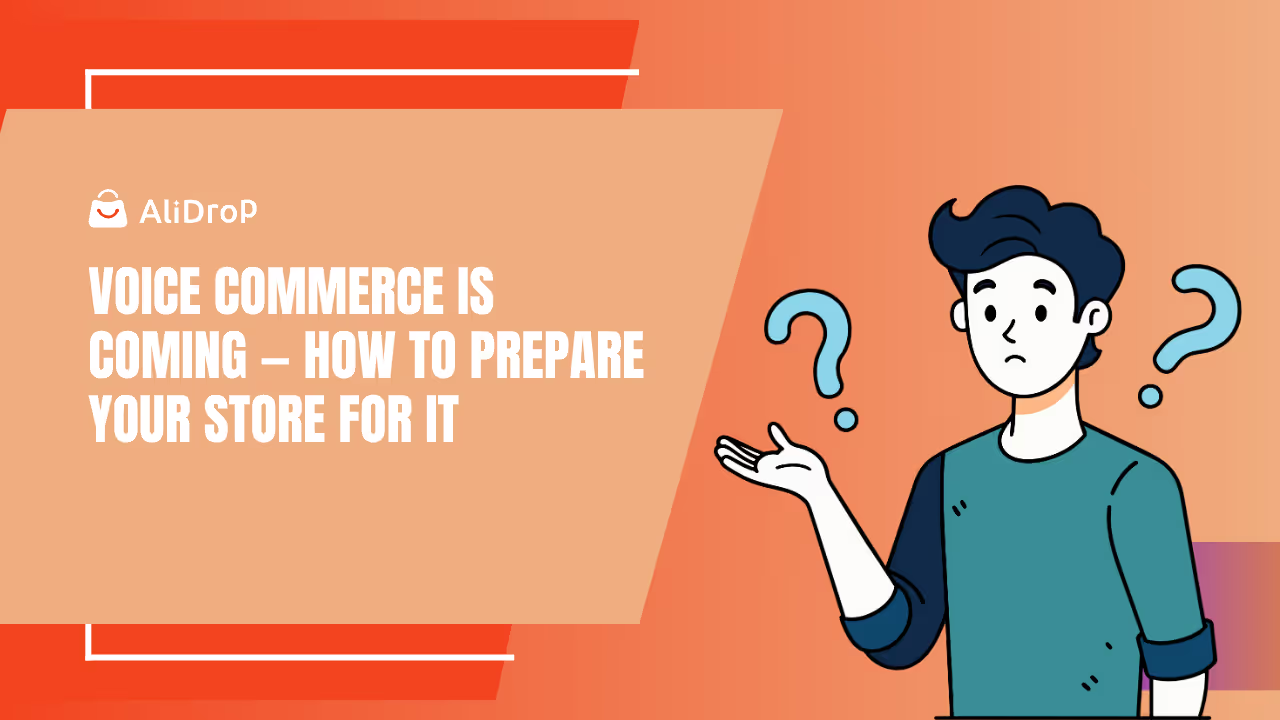Voice commerce is transforming how people shop online. Instead of typing product names, users now say, “Hey Alexa, order green tea bags,” or “OK Google, show me the best wireless headphones.”
This trend is no longer futuristic—it’s happening now. As we move into 2025, voice shopping in eCommerce is expected to cross new milestones..
If you run an online store, this is your chance to lead early. This guide explains everything about voice commerce 2025, from understanding the technology to implementing it in your store step-by-step. You’ll learn how to optimize your website for voice search, integrate voice assistants, and make your eCommerce business future-ready.
Let’s begin.
.avif)
What Is Voice Commerce — A 2025 Perspective
Voice commerce means buying or interacting with eCommerce platforms using voice commands instead of typing or clicking. It’s part of the broader trend of conversational commerce, where consumers use smart assistants to shop and make decisions hands-free.
From Voice Search to Voice Shopping
The shift started with voice search. People began asking Siri, Alexa, or Google simple questions: “What’s the best laptop under $500?” or “Where can I buy organic honey?”
Over time, this evolved into voice shopping, where users can complete full transactions with their voice. Platforms like Amazon Alexa, Google Assistant, and Apple Siri now allow users to reorder items, track deliveries, or even make payments verbally.
Voice shopping bridges convenience with speed—people no longer need to type, browse, and scroll. They can buy products using simple spoken phrases.
Key Technologies Behind Voice Commerce
Voice commerce works through several advanced technologies that understand and respond to human speech:
- Automatic Speech Recognition (ASR): Converts spoken language into text that machines can process.
- Natural Language Processing (NLP): Helps the system understand user intent and context.
- Text-to-Speech (TTS): Allows devices to talk back to users naturally.
- AI & Machine Learning: Learn from user behavior and preferences to deliver personalized product suggestions.
- Voice Assistant APIs: Platforms like Alexa Skills and Google Actions connect your eCommerce backend to voice interfaces.
Together, these technologies create a seamless, conversational shopping experience that feels human-like.
Why 2025 Is a Turning Point
In 2025, voice commerce will go mainstream. Smart speaker adoption has skyrocketed, and nearly every smartphone supports voice assistants. With Gen Z and Millennials preferring instant, hands-free interactions, brands must meet users where they are—through voice.
Also, improvements in multilingual support and accent recognition will make voice shopping more inclusive globally. eCommerce platforms integrating with voice assistants will have a competitive advantage, especially in mobile-first regions.
Why Voice Commerce Matters for eCommerce Stores
Voice commerce isn’t just a cool feature—it’s a strategic business opportunity. It changes how customers search, buy, and engage with your store.
Convenience, Speed & Habit Shift
Consumers love convenience. With voice commerce, they can multitask—shop while driving, cooking, or exercising.
A report from PwC shows that 71% of people prefer voice over typing when possible because it’s faster. Voice shopping reduces friction in the buying journey, leading to higher conversion rates and shorter purchase times.
As voice becomes habitual, shoppers will expect stores to support it. Businesses that adapt early will build loyalty and trust.
Use Cases: Reordering, Quick Purchases
Voice commerce works especially well for repeat purchases or low-involvement items—think groceries, toiletries, or pet food.
For example:
- “Alexa, reorder my toothpaste.”
- “Hey Google, buy coffee beans from my favorite brand.”
These quick commands simplify the process and encourage repeat sales.
Voice also supports product discovery, like when users ask, “What’s the best moisturizer under $20?”—opening doors for your products to be featured through voice search.
Accessibility & Inclusion Advantages
Voice commerce also empowers users who face challenges typing or navigating complex interfaces, including visually impaired or elderly customers.
Adding voice compatibility makes your store more inclusive and aligns with accessibility best practices. Beyond ethics, this inclusivity broadens your customer base and enhances brand reputation.
Mapping the Voice-Driven eCommerce Funnel
Voice changes every stage of the traditional eCommerce funnel—from awareness to advocacy. Let’s explore how.
Discovery & Browsing via Voice
At this stage, users express needs conversationally. For example:
- “What are the best wireless earbuds?”
- “Show me trending sneakers under $100.”
To appear here, your store needs voice-optimized SEO—content that answers direct, conversational questions. Structuring FAQs, using long-tail keywords, and having clean schema markup help your products surface in voice search results.
Evaluation & Comparison by Voice
Once users find options, they ask follow-up questions like:
- “Is this waterproof?”
- “How long does the battery last?”
- “What are people saying about this product?”
Your store’s product descriptions, reviews, and Q&A sections should be detailed, concise, and structured for voice assistants to read aloud. The clearer the answers, the better the experience.
Voice Transactions & Payment Flows
This is where convenience meets security. With voice-enabled checkout, customers can confirm purchases using commands like:
- “Buy this now.”
- “Place my order using default payment.”
Amazon pioneered this with 1-Click Voice Ordering. As a store owner, you can enable similar functionality through APIs or plugins that connect to Alexa or Google.
Always ensure proper authentication steps, such as voice PINs or biometric verification, to maintain trust and prevent accidental purchases.
Post-Purchase & Voice Reorders
Voice assistants also enhance post-purchase interactions:
- “Track my package.”
- “Cancel my last order.”
- “Reorder my favorite shampoo.”
This continuous engagement boosts customer satisfaction and retention, turning one-time buyers into loyal customers.
Step-by-Step: How to Prepare Your Store for Voice Commerce (2025 Ready)
Here’s your complete roadmap to make your online store ready for voice shopping eCommerce.
Phase A: Foundation & Voice-Friendly Site Readiness
- Optimize site speed and mobile performance. Voice users are usually on mobile devices. A slow site can hurt conversion. Compress images, use caching, and ensure fast load times.
- Use structured data markup. Add schema for products, FAQs, reviews, and prices. This helps voice assistants pull relevant info like “price” or “ratings.”
- Simplify navigation and layout. Voice users don’t scroll—so your content must be logically organized for assistants to interpret easily.
- Improve product descriptions. Use natural, spoken language and answer likely questions directly in the content.
- Enable HTTPS and strong security. Voice transactions need secure connections for safe payments.
- Add alt text and accessibility features. This not only helps SEO but ensures voice systems interpret your content better.
Phase B: Keyword Strategy & Conversational Content
Voice queries sound different from typed ones. They’re longer, natural, and question-based.
Example:
- Typed: “best running shoes”
- Voice: “What are the best running shoes for flat feet under $100?”
To optimize:
- Use conversational keywords with tools like AnswerThePublic or Google’s “People Also Ask.”
- Create FAQ pages addressing these questions.
- Write blog posts that mimic natural speech patterns.
- Add featured snippets with concise, direct answers.
- Include location-based keywords if you serve regional markets.
Make your content sound like an actual conversation. The goal is to align with how people talk, not just how they type.
Phase C: Voice Platform Integration (Alexa, Google, Siri)
Once your site is optimized, integrate voice capabilities.
- Alexa Skills: Create a skill for your store that allows users to browse, add items, and reorder. Amazon offers SDKs and templates for eCommerce.
- Google Actions: Integrate with Google Assistant to let customers discover and order directly from voice prompts. Example: “Hey Google, talk to [Your Store Name].”
- Siri Shortcuts: Offer shortcuts for frequent actions like checking order status or viewing promotions. Example: “Hey Siri, open today’s deals at Alidrop.”
- API Integration: Sync your product catalog, cart, and payment APIs with these platforms for seamless checkout.
This integration transforms your store from static pages into a voice-enabled shopping experience.
Phase D: Analytics, Iteration & Voice Feedback
Implementation is just the start. You need to track, measure, and refine.
- Monitor voice interactions: Track which commands users give, which products are requested most, and where they drop off.
- Use analytics tools: Platforms like Google Analytics and Alexa Developer Console provide voice interaction insights.
- Collect voice feedback: Allow users to rate their voice shopping experience.
- Refine based on data: Improve unclear product names, simplify prompts, and fix drop-off points.
Voice commerce thrives on iteration. The more you test, the smarter your system becomes.
Phase E: Launch & Customer Education
Finally, launch your voice-enabled store and educate your customers.
- Promote voice features: Announce the update via email, social media, and your homepage. Example: “Now shop with your voice—just say, ‘Alexa, open Alidrop!’”
- Create tutorials: Post short videos or guides showing how customers can use voice commands.
- Offer incentives: Encourage adoption through discounts for first-time voice orders.
- Gather feedback: Ask users what worked and what didn’t to improve the experience.
Challenges & Risks (and How to Mitigate Them)
Every new technology has challenges. Here’s how to handle them smartly.
Recognition Errors & Accent Variability
Voice assistants sometimes mishear words, especially with strong accents or background noise.
Solution:
- Train your voice app with diverse data samples.
- Use clear product naming.
- Offer visual confirmations before checkout.
Privacy, Trust & Data Protection
Users may hesitate to share sensitive data via voice.
Solution:
- Implement strong encryption.
- Be transparent about data usage.
- Allow users to confirm orders manually or via two-factor authentication.
Ambiguity, Fallbacks & Multi-Intent Handling
Users might give vague commands like “Order the usual.”
Solution:
- Add fallback prompts: “Did you mean to reorder the last item?”
- Use AI to map preferences and clarify intent.
Platform Lock-in & Dependence
Building only for Alexa or Google can limit your reach.
Solution:
- Support multiple platforms.
- Use open APIs so your backend remains flexible.
- Keep control of customer data and experience.
Real-World Examples of Voice Shopping in Action
Let’s see who’s already winning with voice commerce.
Major Brand Use Cases
- Domino’s Pizza: Lets customers order with Alexa or Google. “Alexa, open Domino’s and place my usual order.” It boosted repeat sales and convenience.
- Walmart: Offers “Walmart Voice Order” integrated with Google Assistant. Shoppers can add groceries to their carts hands-free.
- Amazon: Pioneered voice shopping through Alexa, enabling users to reorder from purchase history in seconds.
Smaller / Niche Implementations
- Iroha Nature (Spain): Added voice ordering for skincare. Customers reorder by simply saying, “Order my face mask.”
- Jordan’s Skinny Mixes (USA): Uses Alexa for recipe recommendations and reorder prompts, enhancing engagement.
These examples prove that both large and small businesses can leverage voice shopping effectively.
What Comes After 2025 — Voice Commerce Trends to Watch
Voice commerce will continue to evolve rapidly. Here’s what’s next.
Multimodal & Conversational AI
Voice will merge with visuals. Shoppers will talk to a device and see product options on screens simultaneously. This multimodal experience will make voice shopping more intuitive and interactive.
Contextual / Predictive Ordering
AI will soon predict what customers want before they ask. For instance, your assistant might say, “You’re running low on detergent. Shall I reorder it?”
This predictive commerce will personalize shopping at an unprecedented level.
Voice in IoT, AR, VR
Voice will integrate into smart fridges, cars, and wearables. Imagine saying, “Order milk,” directly to your refrigerator. Combined with AR and VR, it will create fully immersive, conversational shopping experiences.
Voice Commerce Launch Checklist & 30-60-90 Day Plan
Here’s a practical roadmap for your store’s voice commerce journey.
First 30 Days (Foundation)
- Audit site for mobile and speed optimization.
- Add schema markup (Product, FAQ, Review).
- Create conversational FAQs.
- Research voice keywords.
Next 60 Days (Implementation)
- Build Alexa Skill or Google Action.
- Integrate APIs for catalog and payments.
- Add voice-friendly blog content.
- Test commands and error handling.
Next 90 Days (Optimization)
- Launch beta version and gather user feedback.
- Monitor analytics and improve voice interactions.
- Promote on social media and newsletters.
- Prepare advanced voice marketing campaigns.
Conclusion & Next Steps
Voice commerce is no longer optional—it’s the next major evolution of eCommerce. By 2025, consumers will expect hands-free, conversational shopping experiences.
Preparing your store now gives you a clear advantage. Start by optimizing your content for voice, integrating with leading assistants, and offering a seamless, trustworthy user experience.
Remember, early adopters always lead the market. If you begin today, you’ll not only future-proof your business but also create a shopping journey that feels as natural as a conversation.
FAQs on Voice Commerce
What is voice commerce?
Voice commerce is a shopping method that allows customers to browse, search, and purchase products using spoken commands through virtual assistants like Alexa, Google Assistant, or Siri. It offers a hands-free, convenient experience, making buying faster and more accessible for users at home or on the go.
Is voice commerce safe?
Yes, voice commerce is generally safe. Modern platforms use encryption, secure payment gateways, voice recognition, and multi-factor authentication to protect user identities and transactions. As long as customers use trusted devices and retailers, voice-based shopping remains a secure and reliable purchasing method.
How can I make my store voice-ready?
To make your store voice-ready, optimize for voice search by using conversational keywords and structured data. Ensure your store loads fast, integrate with tools like Alexa Skills or Google Actions, and provide clear product information that voice assistants can easily read and interpret.
Which products sell best through voice commerce?
Voice commerce works best for simple, everyday products that require quick reorders—such as groceries, pet supplies, personal care items, and household essentials. These purchases are familiar and low-risk, making users comfortable completing them through voice commands without needing detailed visuals.
Is voice commerce only for big brands?
No, voice commerce isn’t limited to big brands. Small and medium businesses can also leverage it using affordable plugins, APIs, and voice-assistant integrations. With proper SEO and setup, even smaller stores can compete and offer seamless voice shopping experiences to their customers.























